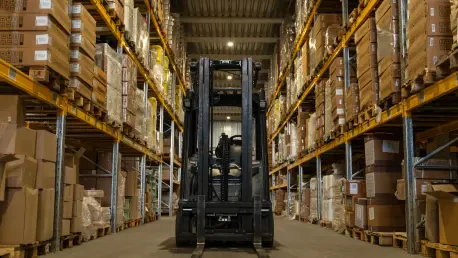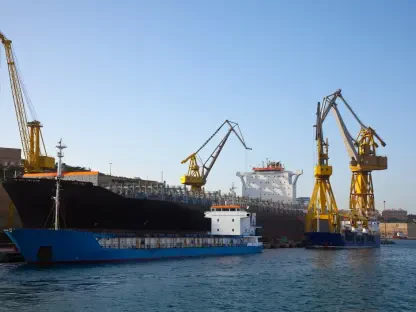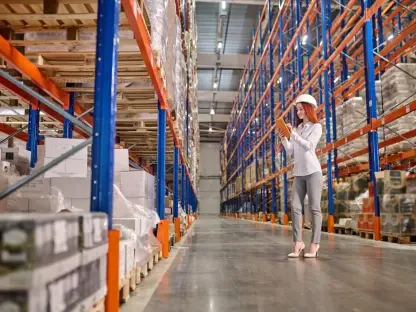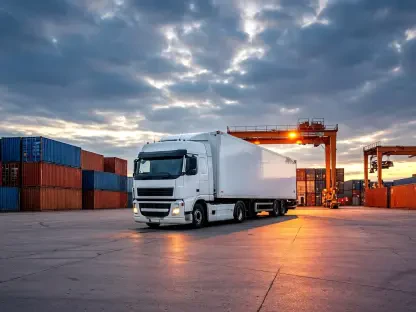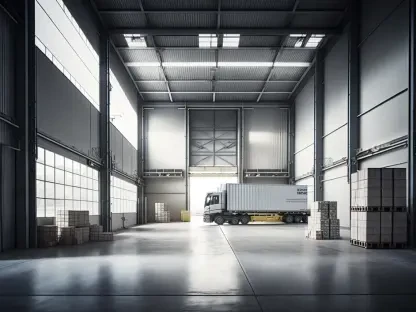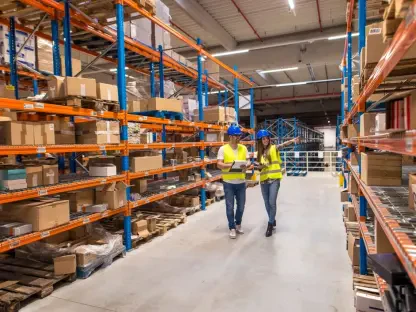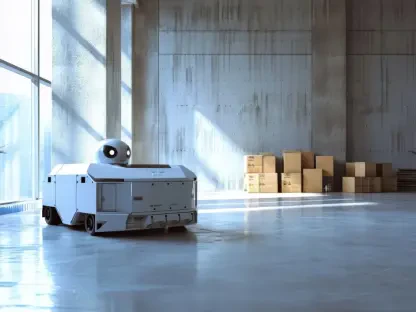Setting the Stage for Safer Warehouses
Imagine a bustling warehouse where forklifts dart through narrow aisles, carrying heavy loads while workers navigate the same space, and each year, thousands of incidents involving forklifts result in injuries or near-misses, often due to human error or lack of visibility. In the high-stakes environment of logistics, where efficiency and safety must coexist, a groundbreaking solution has emerged to tackle these persistent risks. Artificial intelligence, once a distant concept, is now at the forefront of transforming forklift operations, promising to reduce accidents and protect workers in industrial settings. This review dives into a pioneering AI-driven safety system implemented by a leading UK pallet network, exploring how technology is reshaping safety standards in warehousing.
The logistics sector has long grappled with the challenge of balancing operational speed with the well-being of its workforce. Forklift-related accidents remain a significant concern, often stemming from driver fatigue, improper handling, or blind spots in crowded facilities. Traditional safety measures, while helpful, have struggled to address these issues proactively. Enter AI, a tool that not only monitors real-time activity but also predicts and prevents potential hazards. This review focuses on a customized solution that integrates advanced tracking and analytics to elevate safety, offering a glimpse into how innovation is meeting the demands of modern industrial environments.
Core Features of the AI Safety System
Real-Time Monitoring with Tracking and Cameras
At the heart of this AI-driven safety solution lies a sophisticated network of tracking and camera systems installed across an extensive forklift fleet. These components provide unparalleled visibility into daily operations, capturing every movement and interaction within the warehouse. By offering a live feed of activities, the technology ensures that supervisors can monitor driver behavior and equipment usage instantaneously, identifying risks such as improper load handling or unsafe navigation paths before they escalate into incidents.
The cameras serve a dual purpose, acting as both a deterrent to reckless behavior and a tool for post-incident analysis. High-definition footage allows for detailed reviews of specific events, helping to pinpoint the root causes of near-misses or accidents. This level of oversight is critical in environments where split-second decisions can make the difference between safety and disaster, ensuring that accountability and awareness are embedded into every shift.
AI Analytics for Proactive Risk Detection
Beyond mere observation, the system leverages powerful AI algorithms to analyze data collected from the forklifts. These algorithms detect patterns that might indicate safety concerns, such as harsh braking or erratic steering, which could suggest driver distraction or equipment issues. Additionally, the technology is capable of recognizing subtle signs of driver drowsiness, a common yet often overlooked hazard in long-shift operations, allowing for timely interventions.
The analytics go a step further by generating actionable insights that inform safety protocols. For instance, the system can flag areas where accidents are more likely to occur, prompting facility managers to adjust layouts or workflows. By shifting the focus from reactive measures to predictive prevention, this AI-driven approach not only mitigates risks but also fosters a culture of continuous improvement among drivers and staff.
Performance and Industry Impact
Pioneering Implementation in the UK Market
This AI safety solution stands out as a trailblazer in the UK logistics sector, marking the first customized system of its kind tailored specifically for forklift operations. With an investment surpassing £100,000, the initiative reflects a significant commitment to elevating industry standards. Partnering with a leader in connected operations technology, the pallet network behind this rollout has set a benchmark for integrating advanced tools into everyday warehouse practices.
The scale of implementation is notable, covering a network that handles over 4 million pallets annually through more than 90 distribution specialists. This widespread adoption demonstrates the system’s adaptability to diverse operational needs, from small depots to sprawling hubs. The technology’s success in such a vast ecosystem underscores its potential to redefine safety expectations across the board, pushing competitors to follow suit or risk falling behind.
Tangible Safety Improvements
In practice, the system has delivered measurable enhancements to safety performance. By establishing target safety scores for drivers, the technology creates a clear metric for accountability, encouraging consistent adherence to best practices. Tailored training programs, informed by AI-generated data, address individual weaknesses, whether they stem from inexperience or lapses in attention, ensuring that each operator is equipped to handle the demands of their role.
Feedback from the field highlights a reduction in incident rates, attributed to the system’s ability to provide immediate alerts on risky behaviors. Managers can now intervene promptly, whether by offering real-time guidance or scheduling additional training sessions. This dynamic approach not only protects workers but also minimizes downtime caused by accidents, proving that safety and efficiency can indeed go hand in hand in a tech-driven warehouse.
Challenges in Adoption and Scalability
Financial and Technical Barriers
Despite its promise, integrating AI-driven safety systems comes with substantial hurdles. The high initial costs, often running into six figures, can deter smaller companies from adopting such technology, creating a disparity in safety standards across the industry. Additionally, the technical complexity of installation and maintenance requires specialized expertise, which may not be readily available in all regions or firms.
Compatibility with existing infrastructure poses another challenge. Many warehouses operate with legacy equipment that may not seamlessly connect with modern AI systems, necessitating costly upgrades or replacements. Until these financial and technical barriers are addressed, widespread adoption could remain limited to larger players with the resources to invest in such innovations.
Regulatory and Training Obstacles
Regulatory frameworks in the UK have yet to fully catch up with the rapid pace of AI integration in industrial settings. Unlike technologies for heavy goods vehicles, which benefit from more established guidelines, forklift safety systems face ambiguous compliance requirements, slowing their rollout. This gap in policy creates uncertainty for companies considering investment in such solutions.
Moreover, continuous driver training is essential to maximize the system’s effectiveness, yet it presents logistical challenges. Scheduling regular sessions without disrupting operations demands careful planning, and resistance to change among staff can further complicate implementation. Overcoming these human and regulatory obstacles will be key to ensuring that the technology reaches its full potential across diverse workplaces.
Verdict and Next Steps
Reflecting on this AI-driven forklift safety system, the implementation marks a pivotal moment in industrial safety. Its blend of real-time monitoring and predictive analytics delivers concrete improvements, reducing risks and enhancing driver accountability in a demanding sector. The technology proves its worth in a vast network, showcasing scalability and impact that few could have anticipated at the outset.
Looking ahead, the industry must focus on making such systems more accessible by addressing cost barriers through subsidies or modular pricing models. Collaboration between technology providers and regulators could streamline compliance processes, paving the way for broader adoption. Additionally, investing in user-friendly training tools will help bridge the gap between innovation and workforce readiness, ensuring that safety remains a shared priority.
Ultimately, the path forward lies in building on this foundation with enhanced predictive capabilities and integration with other warehouse technologies. Stakeholders should explore partnerships to drive down costs and share best practices, amplifying the reach of AI-driven safety solutions. By prioritizing these steps, the logistics sector can transform isolated successes into a universal standard, safeguarding workers for years to come.
